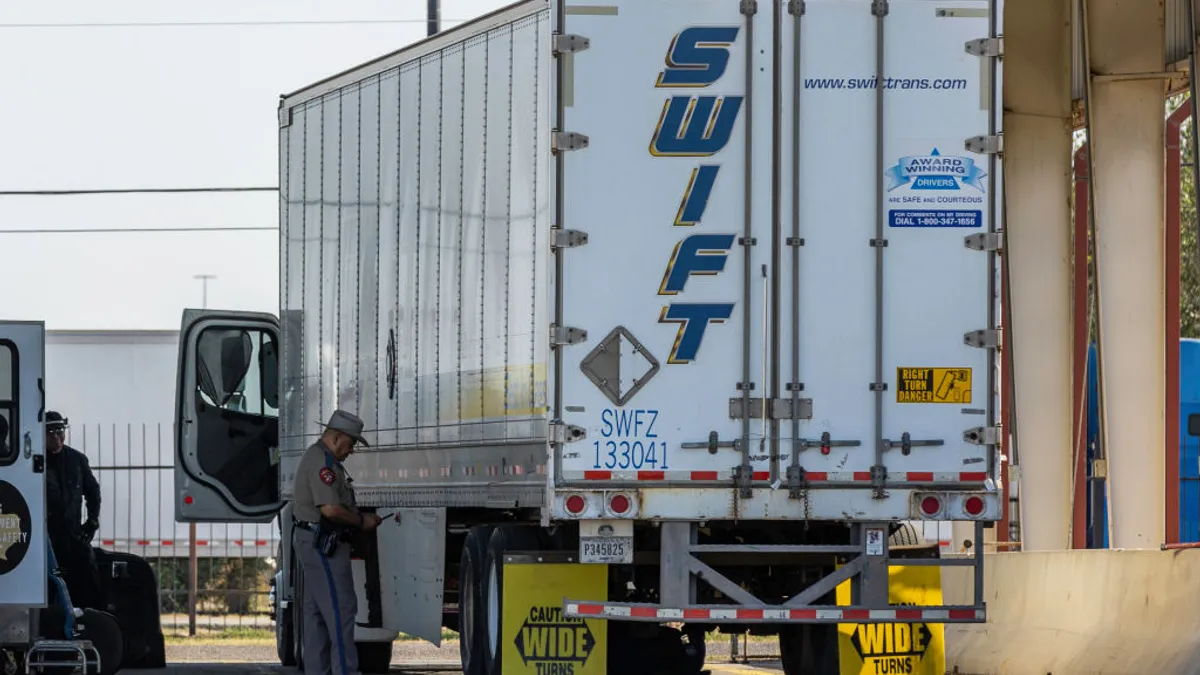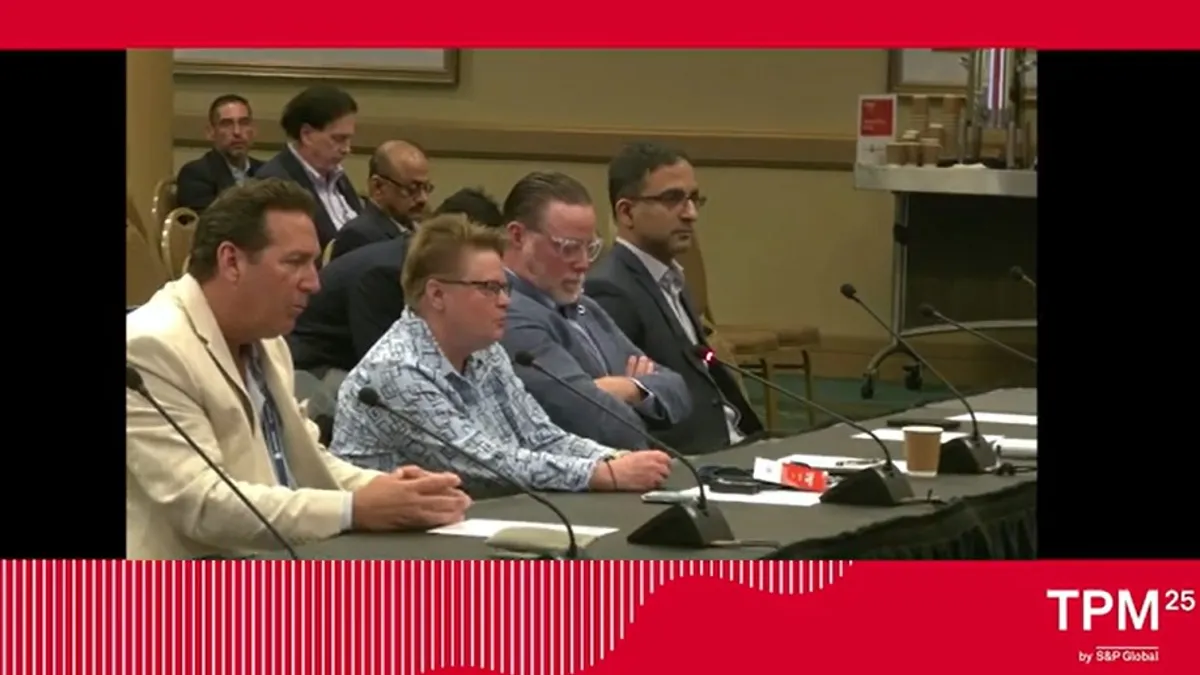When it comes to assessing a company's health, few metrics are more informative than talent retention. For a company shedding its best people, the issue isn't just the expense of turnover — it's the deeper cultural problem it exposes, which, in turn, affects a company's ability to grow.
And yet, despite its importance, talent retention is a tricky metric to master. That's why business leaders go about it in such different ways.
"It's a lot more art than science," said John Bonney, CFO of Harness, a software-deployment company.
Measuring satisfaction
In addition to helping employers avoid replacement costs, strong talent retention levels are associated with higher engagement, satisfaction, productivity and profitability, Jim Burke, CEO of SaaS provider Workforce Logiq, told Transport Dive sister publication HR Dive earlier this year.
Talented workers tend to leave when their company fails to motivate, engage or support them, Lauren Mason, principal and strategic lead for Mercer's Global Rewards Practice, told HR Dive last year. Boredom, dissatisfaction with a manager, or frustration with company direction could all push employees to depart.
But as the pandemic has dragged on in 2020, replacing talented workers is more difficult and costly. A sporadic hiring market, combined with the challenge of training a new staffer remotely, could ultimately throw a wrench into operations and even jeopardize the bottom line.
For this reason, CFOs, in collaboration with their executive colleague in HR, have taken employee retention on as a primary responsibility and treat it as a vital key performance indicator.
"We see people looking for work, and to lose someone on your team right now is highly disruptive," Kelly Garnes, CFO of Gill St. Bernard's, a private preparatory school in Gladstone, New Jersey, said on a panel last month. "There are recruiters looking for people and wanting them to know they'd feel valued at a new company. Though we're in a virtual environment, we all have to take extra effort to make sure team members feel we value their efforts. When you start to take it lightly, they can tell."
"Employers should keep a pulse on engagement using employee engagement surveys that measure commitment and intent to stay with the organization," Mason said. If those leading indicators start to slip, the CFO might consider stepping in and investigating.
Using HR-finance collaboration
Some CFOs tend to get very scientific and quantitative around talent retention, but Raj Dani, CFO of SaaS startup Ping Identity, approaches it differently.
The more engaged the workforce, the more productive and happier they'll be, and that leads to retention, Dani has found. "That's the cycle we're interested in; call it the 'human capital value chain.'"
"Everything around people management" is Dani's favorite part of the CFO job, he said. "We, as managers, have a responsibility to really get to know these individuals."
Dani's finance team and HR team work in lockstep. "We're actively involved in the headcount planning process, making sure the appropriate budget is allocated, and the onboarding process."
In Dani's eyes, retention comes down to getting to know the individual, providing opportunities for them in addition to their day jobs, and encouraging them to find new skills to learn just by getting involved.
"You can work on acquisitions, due diligence, investor materials, earnings scripts, or any of those kinds of things that may not be in your lane as your day job, but are a great way to network with people you may not work with ordinarily, and to add skills to your arsenal," he said.
Dani studies revenue per headcount, attrition statistics by group, trends of compensation, recruiting costs and customer success at a very granular level in search of patterns.
"I'm more interested in what changes, not just in terms of talent retention, but that entire value chain HR brings," Dani said. "How do you leverage the brand to attract the right candidates? How do you keep them engaged? And how do you really measure that?"
Retention as a planning tool
In planning for next year, which he said most CFOs are already doing, Bonney studies annual attrition rates.
"As a baseline, if you have 100 people at the beginning of the quarter and lose 10 of them, that's a 10% quarterly attrition rate, but a 40% annual rate. The problem with that metric is that different groups of your employees will have different healthy attrition rates," Bonney said.
Across departments, zero attrition isn't healthy, either, he said. It may imply the lack of a mechanism for employee evaluation. Bonney names the 10%-15% annualized attrition range as healthy, able to chalk it up to people gradually outgrowing certain roles.
"We understand that, inevitably, folks leave. So, we also track voluntary versus involuntary attrition, or forced versus unforced attrition," he said. "You don't want attrition, but there's a healthy amount in any business ... The problem is it's [often] too late by the time you look at it. You're measuring what's happened, versus what could happen."
Another source of talent retention insights is Glassdoor, the website on which current and former employees share anonymous testimonials of what's good and bad at a company.
"If you look at the venture capital market these days, for funding, Glassdoor scores are really important," he said. "And, yes, you have to take it with a grain of salt and have to understand the trends. But we look at [Glassdoor] religiously, and that's one step ahead of an attrition problem."
If Bonney comes across negative feedback, he first identifies which region or function it's coming from and compares it to scores and trends over time. "Is there a sentiment challenge there?" he'll ask. "We look at it by trend, not as absolute, because you can miss something."
Tracking retention upstream, mid-stream and downstream
Bonney defines Glassdoor, a public-facing aggregator, as mid-stream; attrition is downstream; further upstream is measuring employee engagement through internally circulated surveys.
Bonney and his team use targeted software and surveys to gauge employee sentiment, internally, by function, role and region, which allows them to understand trends before Glassdoor or attrition may reveal them.
From the metric perspective, Harness considers engagement, Glassdoor ratings and attrition all lagging indicators.
A company's needs change as it grows, Bonney said. "The needs change dramatically for different types of roles and can even be more dramatic if a company is growing really fast," he added. "As a startup approaches an IPO, generally, the workforce changes in a healthy way, and the company goes on to be very successful."
Keeping people around is the hardest thing about being a high-growth startup, Bonney said. "You have your product market fit, assuming the product is hitting a need people want, but when you come down to executing a growth plan, that's the hardest part."
Often, a group of people will perform excellently at a certain stage, starting out "super scrappy" and wearing "10 hats."
"As you get into the later stages, you can't wear 10 hats; it's too much work," Bonney said. "We need someone who's really good at wearing three of those hats. There's not really a metric around that, so we rely on having management teams who have hired a lot of people and have been through the cycle."
"The whole executive team has a very vested interest in making sure that the talent retention operates at top ability," Bonney said. He meets with Harness' head of HR every week.
"This may be old-fashioned, but we believe people make the numbers, the numbers don't make the people," he said. "Without the right people in place, executing well, you won't make your goals."
"Looking at it as an upstream/downstream picture, I've learned the further you can look upstream from the lagging indicator, the clearer you can see what's working," he said. "I've seen morale and motivational challenges take a company south quickly. We, fortunately, have a high-caliber, high-morale culture at Harness. So, when we hit a speed bump, we can adjust."
Keeping talent on board
Under Bonney's leadership, Harness has given remote employees subsidies for their work stations and holds biweekly all-hands meetings to ensure employees feel heard.
"What's becoming more important, especially during periods of immense change, is knowing whether we have a burnout challenge somewhere, or if there's somewhere people feel like they always have to be on," he said. "We saw some of that, made some adjustments, and recently made a decision to have mandatory Fridays off once a month."
"I've always said the employer-employee relationship is like any other in life: has to be 50-50 or it's bound for failure," Dani said. "The employee and employer should be giving themselves equally in the relationship. As an employer, I strive to provide exciting work opportunities, like working on the earnings cycle, investor relations, or special projects people don't have exposure to in the day-to-day."
Ping Identity invests in various team building activities and collaborations, as well as development opportunities, because it sees it as its responsibility as an employer, Dani said.
"When you leave Ping Identity, you're leaving as a much stronger professional than when you came in," he said. "And what we ask in return is you give max effort while you're here. Even though we're 1,000 people strong, we still put so much value into culture and development, and that pays back 10 times over every time."
KPI Close-up is a series dedicated to the key metrics CFOs heed to perform in a highly competitive landscape. You can find the entire series here.






















